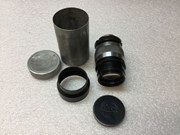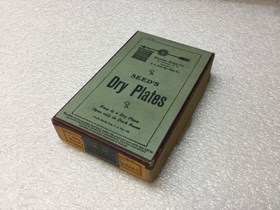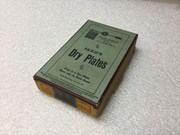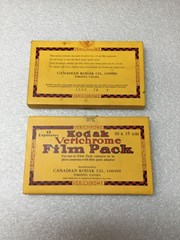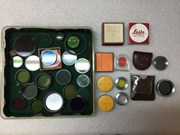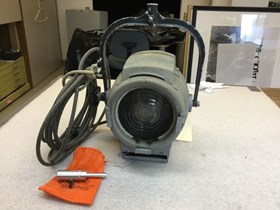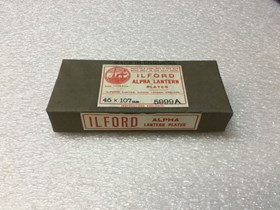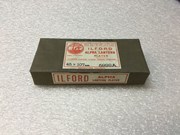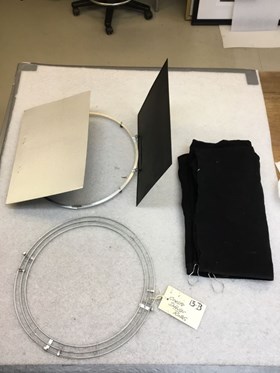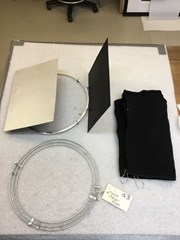Narrow Results By
- Date
- 1931 – 1942
- Material
- metal; glass;
- Catalogue Number
- 104.41.0214
- Description
- Ernst Leitz Wetzlar Hektor f=7,3 cm 1:1,9 lens with hood and lens cap in a metal tube case. The lens cap has Leica engraved on it - the case has the manufacturer name and the lens size stamped on the lid, which slides up off the tube.
1 image
- Title
- Camera Lens
- Date
- 1931 – 1942
- Material
- metal; glass;
- Dimensions
- 8.6 cm
- Description
- Ernst Leitz Wetzlar Hektor f=7,3 cm 1:1,9 lens with hood and lens cap in a metal tube case. The lens cap has Leica engraved on it - the case has the manufacturer name and the lens size stamped on the lid, which slides up off the tube.
- Credit
- Gift of Catharine Robb Whyte, O. C., Banff, 1979
- Catalogue Number
- 104.41.0214
Images
This material is presented as originally created; it may contain outdated cultural descriptions and
potentially offensive content.
Read more.
Exposure Plates
https://archives.whyte.org/en/permalink/artifact104.41.0207
- Date
- 1902 – 1920
- Material
- cardboard; paper; glass;
- Catalogue Number
- 104.41.0207
- Description
- Box of one dozen 3 1/4 x 5 1/2 glass Seed’s Dry Plates with cut paper adhesive tape around the edges and bottom and manufacturer details printed on a pale green background throughout the lid. These dry plates were invented by M.A. Seed in 1879 and became very popular with photographers as the plate…
1 image
- Title
- Exposure Plates
- Date
- 1902 – 1920
- Material
- cardboard; paper; glass;
- Dimensions
- 3.0 x 9.3 x 15.0 cm
- Description
- Box of one dozen 3 1/4 x 5 1/2 glass Seed’s Dry Plates with cut paper adhesive tape around the edges and bottom and manufacturer details printed on a pale green background throughout the lid. These dry plates were invented by M.A. Seed in 1879 and became very popular with photographers as the plates came pre-prepared with the emulsion layer already applied - prior to “dry” plates, photographers would need portable dark rooms in which they would create their liquid emulsions prior to taking a photograph [known as “wet” plates]. Seed’s dry plates still required they be opened in a dark room, but this could be accomplished in the field by placing a dark sheet over the camera while loading and unloading the plates. In 1902, Eastman Kodak purchased Seed’s company [Seed Dry Plate Co.], but continued to capitalize on his name due to its reputation among consumers.
- Credit
- Gift of Robert Crosby Family, Banff, 1998
- Catalogue Number
- 104.41.0207
Images
This material is presented as originally created; it may contain outdated cultural descriptions and
potentially offensive content.
Read more.
- Date
- 1938 – 1945
- Material
- cardboard;
- Catalogue Number
- 104.41.0204 a,b
- Description
- Two boxes of 12 10x15cm Kodak Verichrome Film Packs with broken seals. Each box is mostly yellow with black and red manufacturer and product details throughout - there are two paper adhesive stickers holding the box closed, the one that has the expiration date on it on each box is broken.Verichrome…
1 image
- Title
- Film Pack
- Date
- 1938 – 1945
- Material
- cardboard;
- Dimensions
- 1.4 x 17.9 x 10.9 cm
- Description
- Two boxes of 12 10x15cm Kodak Verichrome Film Packs with broken seals. Each box is mostly yellow with black and red manufacturer and product details throughout - there are two paper adhesive stickers holding the box closed, the one that has the expiration date on it on each box is broken.Verichrome was a kind of panchromatic film that yielded high-quality black and white photographs thanks to the fine-grained emulsion. Film Packs were basic forms of storage meant to be used shortly after purchasing as their [mostly] paper packaging did not keep out oxygen well and had a tendency to fog over time, rendering the film unusable in the long term. It was replaced by the more stable Verichrome Pan in the 1950s.
- Credit
- Gift of Robert Crosby Family, Banff, 1998
- Catalogue Number
- 104.41.0204 a,b
Images
This material is presented as originally created; it may contain outdated cultural descriptions and
potentially offensive content.
Read more.
- Date
- 1930 – 1970
- Material
- plastic; fabric; felt; leather; glass; cardboard;
- Catalogue Number
- 104.41.0212
- Description
- Square clear plastic box lined with green felt containing 26 camera filters and 2 lens caps - 6 filters are in various containers, one is unopened. Most filters were manufactured by Leitz Wetzler [the company changed its name to Leica in 1986], some are Kodak, and two are Zeiss. Filters include yel…
1 image
- Title
- Filter Box
- Date
- 1930 – 1970
- Material
- plastic; fabric; felt; leather; glass; cardboard;
- Dimensions
- 3.8 x 23.2 x 23.2 cm
- Description
- Square clear plastic box lined with green felt containing 26 camera filters and 2 lens caps - 6 filters are in various containers, one is unopened. Most filters were manufactured by Leitz Wetzler [the company changed its name to Leica in 1986], some are Kodak, and two are Zeiss. Filters include yellow, orange, red, blue, tinted, and clear patterned glass.
- Credit
- Gift of Catharine Robb Whyte, O. C., Banff, 1979
- Catalogue Number
- 104.41.0212
Images
This material is presented as originally created; it may contain outdated cultural descriptions and
potentially offensive content.
Read more.
- Date
- 1940 – 1960
- Material
- metal; glass; plastic; fabric;
- Catalogue Number
- 102.05.0115
- Description
- Dull grey metal flood/spotlight used in studio settings for film-making or photography. The main body of the light is shaped like a small barrel - one end has a carved crystal bordered in thick cord and the other has a door that opens by pushing a small button in order to access the light bulb insi…
1 image
- Title
- Flood Light
- Date
- 1940 – 1960
- Material
- metal; glass; plastic; fabric;
- Dimensions
- 42.0 x 28.0 x 31.0 cm
- Description
- Dull grey metal flood/spotlight used in studio settings for film-making or photography. The main body of the light is shaped like a small barrel - one end has a carved crystal bordered in thick cord and the other has a door that opens by pushing a small button in order to access the light bulb inside. The centre of the door features the Bardwell & McAlister Inc. logo. The barrel also has housing attached to the top and bottom - one contains a lever that, when pushed from side to side, moves the light bulb inside closer to or further from the crystal. Attached to the front on either side of the crystal are brackets where a filter can be fit; a Y-shaped support can be rotated 180 degrees and is adjusted by a handle on one side; an on/off switch sits in a raised metal bracket on one side, and near the switch the power cord feeds out of the barrel - the cord is wrapped in grey fabric and is coiled up and attached to the support with a short length of rope. Attached to the power cord is an orange fabric bag with a wire drawstring that contains a silver metal cylinder that could possibly be an attachment for the support.
- Credit
- Gift of Nicholas Morant, Banff, 2006
- Catalogue Number
- 102.05.0115
Images
This material is presented as originally created; it may contain outdated cultural descriptions and
potentially offensive content.
Read more.
- Date
- 1940 – 1960
- Material
- metal; glass; plastic;
- Catalogue Number
- 102.05.0116
- Description
- Dull grey metal flood/spotlight used in studio settings for film-making or photography. The main body of the light is shaped like a small barrel - one end has a carved crystal bordered in thick cord and the other has a door that opens by pushing a small button in order to access the light bulb insi…
1 image
- Title
- Flood Light
- Date
- 1940 – 1960
- Material
- metal; glass; plastic;
- Dimensions
- 42.0 x 28.0 x 31.0 cm
- Description
- Dull grey metal flood/spotlight used in studio settings for film-making or photography. The main body of the light is shaped like a small barrel - one end has a carved crystal bordered in thick cord and the other has a door that opens by pushing a small button in order to access the light bulb inside. The centre of the door features the Bardwell & McAlister Inc. logo. The barrel also has housing attached to the top and bottom - one contains a lever that, when pushed from side to side, moves the light bulb inside closer to or further from the crystal. Attached to the front on either side of the crystal are brackets where a filter can be fit; a Y-shaped support can be rotated 180 degrees and is adjusted by a handle on one side; an on/off switch sits in a raised metal bracket on one side, and near the switch the black plastic power cord feeds out of the barrel - the cord is coiled up and attached to the support with a short length of rope.
- Credit
- Gift of Nicholas Morant, Banff, 2006
- Catalogue Number
- 102.05.0116
Images
This material is presented as originally created; it may contain outdated cultural descriptions and
potentially offensive content.
Read more.
Lantern Plates
https://archives.whyte.org/en/permalink/artifact104.41.0206
- Date
- 1889 – 1910
- Material
- paper; glass;
- Catalogue Number
- 104.41.0206
- Description
- One paper-wrapped package of 45x107mm Ilford Alpha Lantern Plates with white and red paper adhesive labels on the top and front of the package containing manufacturer details. These lantern plates would serve as the positive mount for the lantern slide made from the original negative. Lantern slide…
1 image
- Title
- Lantern Plates
- Date
- 1889 – 1910
- Material
- paper; glass;
- Dimensions
- 2.0 x 11.6 x 5.3 cm
- Description
- One paper-wrapped package of 45x107mm Ilford Alpha Lantern Plates with white and red paper adhesive labels on the top and front of the package containing manufacturer details. These lantern plates would serve as the positive mount for the lantern slide made from the original negative. Lantern slides are glass-based transparencies that were displayed by being projected through an early projector called a magic lantern. Starting as hand-painted images on glass, lantern slides quickly adapted to first black-and-white and then colour photography and faded from popularity with the rise of celluloid film and motion pictures.
- Credit
- Gift of Robert Crosby Family, Banff, 1998
- Catalogue Number
- 104.41.0206
Images
This material is presented as originally created; it may contain outdated cultural descriptions and
potentially offensive content.
Read more.
- Date
- 1960 – 1986
- Material
- cardboard; metal; glass;
- Catalogue Number
- 104.41.0197
- Description
- Small round silver metal 5 cm camera lens attachment with small horizontal runners that slide into the base on the tops of most cameras. This lens is most likely a specifically-adjusted sight for a larger lens, based on the small size and the presence of a black rectangle printed on the glass of th…
1 image
- Title
- Lens
- Date
- 1960 – 1986
- Material
- cardboard; metal; glass;
- Dimensions
- 2.6 x 3.8 x 4.4 cm
- Description
- Small round silver metal 5 cm camera lens attachment with small horizontal runners that slide into the base on the tops of most cameras. This lens is most likely a specifically-adjusted sight for a larger lens, based on the small size and the presence of a black rectangle printed on the glass of the lens.The box consists of a white cardboard body with a partially torn housing inside for the lens that slides horizontally into a green cardboard sleeve. The green section has a narrow strip of adhesive tape around it, blocking most of the text on both the top and bottom - a small white rectangular price tag with “10.20” written on it in blue ink also obscures the text on the box.
- Credit
- Gift of Robert Crosby Family, Banff, 1998
- Catalogue Number
- 104.41.0197
Images
This material is presented as originally created; it may contain outdated cultural descriptions and
potentially offensive content.
Read more.
- Date
- 1950 – 1980
- Material
- metal; fabric;
- Catalogue Number
- 102.05.0118 a-c
- Description
- Two metal light diffuser attachments, one with adjustable hood, and a black fabric screen. The metal rings serve as housing for different kinds of paper, fabric, or celluloid filters and can be fitted over a flood or spotlight in studio settings.
1 image
- Title
- Light Diffuser
- Date
- 1950 – 1980
- Material
- metal; fabric;
- Dimensions
- 4.5 x 47.2 x 42.0 cm
- Description
- Two metal light diffuser attachments, one with adjustable hood, and a black fabric screen. The metal rings serve as housing for different kinds of paper, fabric, or celluloid filters and can be fitted over a flood or spotlight in studio settings.
- Credit
- Gift of Nicholas Morant, Banff, 2006
- Catalogue Number
- 102.05.0118 a-c
Images
This material is presented as originally created; it may contain outdated cultural descriptions and
potentially offensive content.
Read more.
- Date
- 1950 – 1980
- Material
- wood; fabric; metal; plastic; paper;
- Catalogue Number
- 104.41.0167 a-d
- Description
- Several, mostly round, filters in wire frames that could be fit onto stage lights for studio photo shoots housed in a [possibly homemade] wooden box with a rope handle on top and Nicholas Morant’s name and title adhered to the front. Three filters are translucent white fabric, two contain coloured …
1 image
- Title
- Light Filter
- Date
- 1950 – 1980
- Material
- wood; fabric; metal; plastic; paper;
- Dimensions
- 36.8 x 14.2 x 34.2 cm
- Description
- Several, mostly round, filters in wire frames that could be fit onto stage lights for studio photo shoots housed in a [possibly homemade] wooden box with a rope handle on top and Nicholas Morant’s name and title adhered to the front. Three filters are translucent white fabric, two contain coloured cellophane [one blue, one green], and the rest are loose sheets of cellophane in various colours [including red, blue, green, and orange] - most are square, two are round. Also included in the box are pieces of cardboard to keep them separated, four sheets of coloured construction paper and a large paper folder advertising “The Rimrock,” and a circular blue fabric cover possibly used to house/protect filters in transport.
- Credit
- Gift of Nicholas Morant, Banff, 2006
- Catalogue Number
- 104.41.0167 a-d
Images
This material is presented as originally created; it may contain outdated cultural descriptions and
potentially offensive content.
Read more.


